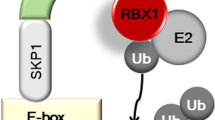Abstract
Signal transducer and activator of transcription 3 (STAT3) play key roles in the intracellular signaling pathways of the interleukin (IL)-6 family of cytokines, which exhibit a diverse set of cellular responses, including cell proliferation and differentiation. Dysregulated IL-6/STAT3 signaling is involved in the pathogenesis of several diseases, for example autoimmune diseases and tumors. Type I interferon (IFN) induces the expression of proapoptotic genes and has been used in the clinical treatment of several tumors. In the present study, we found that type I IFN suppressed IL-6/STAT3-mediated transcription and gene expression. Furthermore, a type I IFN-induced protein, Daxx, also suppressed STAT3-mediated transcriptional activation, while overexpression of Daxx inhibited IL-6/STAT3-mediated gene expression. Importantly, small-interfering RNA-mediated reduction of Daxx expression enhanced IL-6/leukemia inhibitory factor (LIF)-induced STAT3-dependent transcription. Co-immunoprecipitation studies revealed a physical interaction between Daxx and STAT3 in transiently transfected 293T cells. We further found that Daxx and STAT3 were co-localized in the nucleus. These results indicate that Daxx may serve as a transcriptional regulator of type I IFN-mediated suppression of the IL-6/STAT3 signaling pathway.
This is a preview of subscription content, access via your institution
Access options
Subscribe to this journal
Receive 50 print issues and online access
$259.00 per year
only $5.18 per issue
Buy this article
- Purchase on Springer Link
- Instant access to full article PDF
Prices may be subject to local taxes which are calculated during checkout



Similar content being viewed by others
References
Brender C, Nielsen M, Ropke C, Nissen MH, Svejgaard A, Billestrup N et al. (2001). Exp Clin Immunogenet 18: 80–85.
Bromberg J . (2000). Breast Cancer Res 2: 86–90.
Bromberg JF, Wrzeszczynska MH, Devgan G, Zhao Y, Pestell RG, Albanese C et al. (1999). Cell 98: 295–303.
Darnell Jr JE, Kerr IM, Stark GR . (1994). Science 264: 1415–1421.
Hirano T, Nakajima K, Hibi M . (1997). Cytokine Growth Factor Rev 8: 241–252.
Hollenbach AD, McPherson CJ, Mientjes EJ, Iyengar R, Grosveld G . (2002). J Cell Sci 115: 3319–3330.
Hollenbach AD, Sublett JE, McPherson CJ, Grosveld G . (1999). EMBO J 18: 3702–3711.
Ihle JN . (1995). Nature 377: 591–594.
Ishov AM, Sotnikov AG, Negorev D, Vladimirova OV, Neff N, Kamitani T et al. (1999). J Cell Biol 147: 221–234.
Jelinek DF, Aagaard-Tillery KM, Arendt BK, Arora T, Tschumper RC, Westendorf JJ . (1997). J Clin Invest 99: 447–456.
Kim EJ, Park JS, Um SJ . (2003). Nucleic Acids Res 31: 5356–5367.
Kirkwood JM, Farkas DL, Chakraborty A, Dyer KF, Tweardy DJ, Abernethy JL et al. (1999). Mol Med 5: 11–20.
Levy DE, Lee CK . (2002). J Clin Invest 109: 1143–1148.
Li H, Leo C, Zhu J, Wu X, O'Neil J, Park EJ et al. (2000a). Mol Cell Biol 20: 1784–1796.
Li R, Pei H, Watson DK, Papas TS . (2000b). Oncogene 19: 745–753.
Li Z, Metze D, Nashan D, Muller-Tidow C, Serve HL, Poremba C et al. (2004). J Invest Dermatol 123: 737–745.
Muromoto R, Sugiyama K, Takachi A, Imoto S, Sato N, Yamamoto T et al. (2004a). J Immunol 172: 2985–2993.
Muromoto R, Sugiyama K, Yamamoto T, Oritani K, Shimoda K, Matsuda T . (2004b). Biochem Biophys Res Commun 316: 827–833.
Nakajima K, Yamanaka Y, Nakae K, Kojima H, Ichiba M, Kiuchi N et al. (1996). EMBO J 15: 3651–3658.
Platanias LC . (2005). Nat Rev Immunol 5: 375–386.
Shimoda K, Kamesaki K, Numata A, Aoki K, Matsuda T, Oritani K et al. (2002). J Immunol 169: 4707–4711.
Torii S, Egan DA, Evans RA, Reed JC . (1999). EMBO J 18: 6037–6049.
Zhong S, Salomoni P, Ronchetti S, Guo A, Ruggero D, Pandolfi PP . (2000). J Exp Med 191: 631–640.
Acknowledgements
This work was supported in part by grants from the Osaka Foundation for Promotion of Clinical Immunology, the Naito Foundation, the Akiyama Foundation and the Sasakawa Scientific Research Grant from The Japan Science Society.
Author information
Authors and Affiliations
Corresponding author
Rights and permissions
About this article
Cite this article
Muromoto, R., Nakao, K., Watanabe, T. et al. Physical and functional interactions between Daxx and STAT3. Oncogene 25, 2131–2136 (2006). https://doi.org/10.1038/sj.onc.1209235
Received:
Revised:
Accepted:
Published:
Issue Date:
DOI: https://doi.org/10.1038/sj.onc.1209235
Keywords
This article is cited by
-
Epigenetic silencing of the NR4A3 tumor suppressor, by aberrant JAK/STAT signaling, predicts prognosis in gastric cancer
Scientific Reports (2016)
-
Inhibition of STAT3-interacting protein 1 (STATIP1) promotes STAT3 transcriptional up-regulation and imatinib mesylate resistance in the chronic myeloid leukemia
BMC Cancer (2014)



